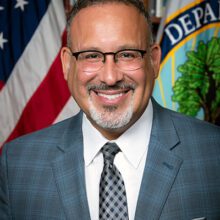For countless communities across our nation, a strong rural education means a strong public education.
Last year, I visited Hatton-McCredie Elementary School, a small, rural public school in Kingdom City, Missouri – a town of little less than 150 residents. My tour was led by two fifth-grade guides, Paxton and Haylee.
I remember how excited Paxton and Haylee were to show off their public school – and for good reason. I saw brightly-colored classrooms and students engaged in challenging work. I met phenomenal teachers and leadership. I felt the generous, vibrant community that respected and uplifted one another.
When I remember that tour, I think particularly of the teacher self-care room. This designated area, where teachers could go when they felt overwhelmed or stressed, was a true reflection of the community’s values. This space was made possible because leadership connected with staff as neighbors and friends, not just as employees. This space was made possible because parents and families donated exercise equipment and other items, recognizing the vital role of teachers in helping their community thrive.
Across our country, schools like Hatton-McCredie are the hub of their communities. For the 9 million students attending rural public schools every day, these buildings are more than places to learn. They’re connection. They’re community.
Unfortunately, in states across the country, some politicians and well-funded special interests are busy attacking public education instead of defending it and investing in it. Left unchallenged, these efforts to undermine public education could cause grave harm to rural communities that rely on quality local public schools to open doors for their students.
Right now, some states are moving hundreds of millions of dollars away from these public schools and into private schools. Public schools are often among the largest employers in rural communities, so dips in enrollment have outsized and sometimes devastating effects.
Public schools risk teacher and staff layoffs. Programs risk funding. Rural students with disabilities – who, along with other underserved students, are often not promised seats at private schools – risk not receiving needed supports.
Ultimately, rural public schools risk closure – an outcome that deprives rural students of choice instead of giving them more options.
Private schools tend to be closer to students in cities and suburbs than they are to their rural peers. Rural families might have to travel farther to attend a private school – contending with the transportation, employment, and financial challenges that come with added time and distance. For these families, rural public school is the nearest and best option – and these families deserve our investment, advocacy, and support.
After all, these schools are lifelines for so many students and families.
Nine out of every ten counties with the highest food insecurity rates are rural. Public schools are providing nutritious meals.
With more than 190 rural hospitals closing across the United States since 2005, public schools are staffing healthcare providers, including mental health professionals.
Public schools are providing broadband access to many of the more than 20% of rural Americans without it.
For our American Indian and Alaska Native students – most of whom live in rural areas or small towns – public schools can be central to uplifting the cultures, histories, and voices of Native communities.
In every state, rural school leaders are among the most resourceful in our nation. They’re embracing home-grown solutions to truly complex problems – in infrastructure, healthcare, transportation, and housing. These leaders don’t often have the same access to funding and partners as peers in bigger cities and towns, but their work shows all of us how deeply rural public schools matter.
The Biden-Harris Administration believes in the life-changing – and life-saving – power of these schools. It’s why, last year, we invested one-third of our $74 million Full-Service Community Schools awards to schools that serve rural students – bringing cradle-to-career supports and a high-quality education to neighborhood schools.
At these community schools, parents and caregivers can attend classes that lead to certifications and employment in in-demand fields.
And students and families can take advantage of walk-in health clinics to get needed medical, dental, and vision care.
Our vision for rural America is based on partnership, not division. It’s based on action, not disinvestment.
Excellence lives in rural America. It’s why students like Paxton and Haylee – and so many just like them – are so proud of their public schools. If we want to ensure our rural communities thrive with each passing generation, we must commit to and invest in the millions of students who live and learn there right now.
This article first appeared on The Daily Yonder and is republished here under a Creative Commons license.![]()





